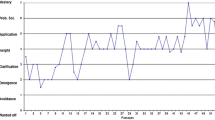Abstract
This commentary on six papers about assimilative integration considers the place assimilative integration, as defined by Messer, ought to have in the discussion on psychotherapy integration. After briefly summarizing the contribution of each paper, with particular attention to whether the paper takes a position on the end point of psychotherapy integration, the author compares the relative benefits of assimilative integration to those of a unified grand theory. He argues that assimilative integration, as an end point, is preferable to a unified grand theory because it has a more generative influence on both theory evolution and clinical practice.
Similar content being viewed by others
REFERENCES
Lazarus, A. A., & Messer, S.B. (1991). Does chaos prevail?Anexchange on technical eclecticism and assimilative integration. Journal of Psychotherapy Integration, 1, 143–158.
Messer, S. B. (1992). A critical examination of belief structures in integrative and eclectic psychotherapy. In J. C. Norcross & M. R. Goldfried (Eds.), Handbook of psychotherapy integration (pp. 130–165). New York: Basic Books.
Author information
Authors and Affiliations
Rights and permissions
About this article
Cite this article
Fisch, E.S. What is the End Point of Psychotherapy Integration? A Commentary. Journal of Psychotherapy Integration 11, 117–122 (2001). https://doi.org/10.1023/A:1026685109845
Issue Date:
DOI: https://doi.org/10.1023/A:1026685109845




